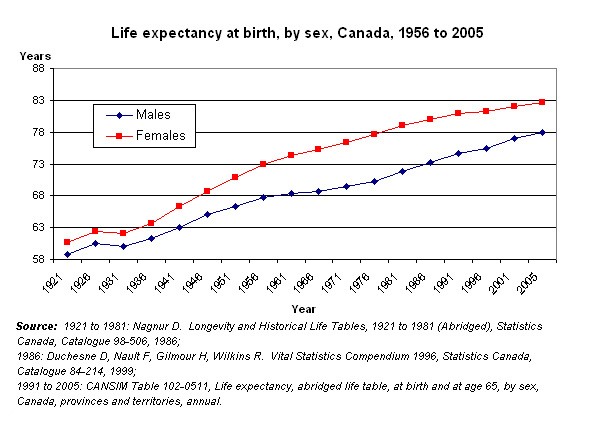You are using an out of date browser. It may not display this or other websites correctly.
You should upgrade or use an alternative browser.
You should upgrade or use an alternative browser.
[RD] Daily Graphs and Charts
- Thread starter Winner
- Start date
- Status
- Not open for further replies.
madviking
north american scum
why is it upside down????
SS-18 ICBM
Oscillator
Reminiscent of blood dripping down a surface.
madviking
north american scum
he also said he's improved weather by 15%
Sorta, kinda. You use age specific mortality rates to construct the life tables that allow you to calculate life expectancy. Life tables work... something like this:peter grimes said:So is it useful to think of Mortality rate as a sort of inverse of the Life Expectancy? I'm still befuddled.
You create a hypothetical cohort of 100 000 babies and kill them off using the age specific mortality rates. Eventually, you run out of your original babies to kill. The result is a curve which allows you to derive stuff like life expectancy. Life expectancy being the expected number of years of life remaining at a given age. Please note, that what we usually term life expectancy is actually 'life expectancy at birth' i.e. the expected number of years someone born today would have to live. (It's also important to note that life expectancy assumes that the babies are subject to the same age specific mortality rates of the reference period. Given that medical science is constantly improving, it follows that as our actual life expectancy is somewhat higher than the life expectancy that was calculated at our birth!)
I hope that helps clear things up!
Eventually, you run out of your original babies to kill
I love the way you explain things.
Terxpahseyton
Nobody
- Joined
- Sep 9, 2006
- Messages
- 10,759
That doesn't make sense to me. How can there be a reasonable projection how long people live who are born today? Wouldn't it make more sense to look at the average age of death of the year to determine how long people right now tend to live?Please note, that what we usually term life expectancy is actually 'life expectancy at birth' i.e. the expected number of years someone born today would have to live.
Terxpahseyton said:That doesn't make sense to me. How can there be a reasonable projection how long people live who are born today?
That's a fair question. The answer to which is... that the public doesn't really understand life expectancy. People like to think that life expectancy incorporates innovations in medical science and that's a reasonable sort of wish. But the reason demographers don't do that is because its impossible to know what medical science is going to do over the next eight decades.
This doesn't stop demographers from making adjustments to their life tables to try and work out what might age people might live too given certain assumptions about the pace of medical innovation and so forth. This is usually called an expected life expectancy because it incorporates assumptions (expectations) about where things might be going.
Terxpahseyton said:Wouldn't it make more sense to look at the average age of death of the year to determine how long people right now tend to live?
That would tend to understate life expectancy.
This is why I like looking at other trends.

vs.

The first graph shows 'late life medical progress' much better than the second graph, even though you can still get good upwards momentum on later life based on early life (look ma! healthy bones!). So, part of this increase is due to societal changes that occurred 50-80 years ago.

vs.

The first graph shows 'late life medical progress' much better than the second graph, even though you can still get good upwards momentum on later life based on early life (look ma! healthy bones!). So, part of this increase is due to societal changes that occurred 50-80 years ago.
Traitorfish
The Tighnahulish Kid

Don't worry, anti-socialist crusaders, you're still spending a wee bit more on guns than you are on children.
EDIT: the disclaimer at the bottom of TF's graph explains that this is only Income Taxes, not Payroll taxes which directly fund Medicare & SS.
From the same site:

KMRblue1027
Deity
Add up education, transportation, environment and science and it's still not close to military spending. 

You can see why people are worried about the debt. The current interest rate is pretty low, and if the debt payment cost rose to any type of historical norm, it would effectively gobble up a decent portion of the budget.
Hygro
soundcloud.com/hygro/
You can see why people are worried about the debt. The current interest rate is pretty low, and if the debt payment cost rose to any type of historical norm, it would effectively gobble up a decent portion of the budget.
Fortunately interest rates are a policy variable

Monsterzuma
the sly one
- Joined
- Jun 1, 2008
- Messages
- 2,984
real interest rates aren't.
Fortunately interest rates are a policy variable
No, not really. In the end, people want a specific rate of return on their investments.
Hygro
soundcloud.com/hygro/
The formal definition of real interest rate is nominal interest rate (set by the Fed) minus inflation. Do you mean something else?real interest rates aren't.
No, not really. In the end, people want a specific rate of return on their investments.
And they have no say in the matter... Unless you're saying the Fed is corrupt?
The only way the Fed can lose control of the interest rate given its current powers is if the US loses control of the dollar, which is highly unlikely. In the end, treasuries are almost always better than cash and as long as there is demand for cash, there is more demand for treasuries.
- Status
- Not open for further replies.
Similar threads
- Poll
- Replies
- 120
- Views
- 8K


